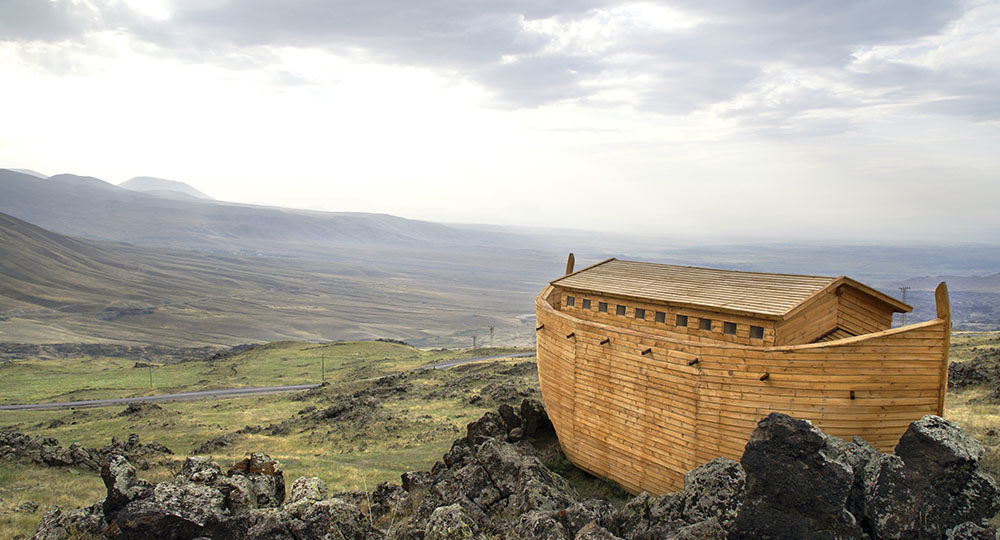The Seven Keys to History Part Three
Catastrophe
Have you ever heard the expression “the then world”? It comes from 2 Peter 3:
For this they willfully forget: that by the word of God the heavens were of old, and the earth standing out of water and in water….The world that then existed perished, being flooded with water. But the heavens and the earth which are now preserved by the same word, are reserved for fire (vv. 5–7).
In the original Greek, the phrase the world that then existed means “the then world.” The third key to history involves understanding what happened to that world. In a word, it was catastrophe.
The Human Calendar
There were 1,656 years between the creation of Adam and the universal flood. Since the ancient world did not calculate time as we do, God provided a human calendar:
- “And Adam lived one hundred and thirty years, and begot a son in his own likeness, after his image, and named him Seth. After he begot Seth, the days of Adam were eight hundred years” (Gen. 5:3–4). So Adam lived 130 plus 800, for a total of 930 years.
- “Seth lived one hundred and five years, and begot Enosh. After he begot Enosh, Seth lived eight hundred and seven years” (total of 912 years, vv. 6–7).
- “Enosh lived ninety years, and begot Cainan. After he begot Cainan, Enosh lived eight hundred and fifteen years, and had sons and daughters” (total of 905 years, vv. 9–10). So on and so forth.
The list is not a strict “father, first-born son” genealogy because Seth was not Adam’s firstborn. Cain and Abel preceded him. However, Scripture gives us a godly line that functions as a calendar. If you tally everything, you have 1,656 years between Adam’s creation and the Noahic flood.
Some people say you can’t trust the Bible’s numbers. However, if you can’t trust Genesis 5, how can you trust John 3 or Romans 3, which speak of God’s love and His provision for our salvation through Christ? If you deny the truth of Genesis, you might as well create your own theology—which is exactly what many people today do.
In the Garden of Eden, Adam and Eve were responsible to govern the earth in worshipful submission to God, thereby glorifying Him. From Genesis 3 through the flood, humanity’s responsibility was to glorify God by living with a clear conscience. Today we still have those responsibilities, however many other things have changed.
The Then World
The then world apparently had a temperate global climate that changed with the catastrophe of the universal flood. It appears a canopy of water hung above the earth because, in Genesis 1, God separated the waters above the firmament from those below it. This massive water bubble diffused the sun’s rays and created a closed ecosystem much like a terrarium. There were no polar ice caps, and Earth’s climate was ideal all the time.
The Bible is also clear it never rained, nor was there a rainbow. There were no typhoons, hurricanes, or devastating weather systems. Furthermore, Earth’s landmass appears to have been contiguous; people could virtually walk around the planet.
So prior to the flood, Earth was vastly different. Also different was the human lifespan. People lived almost 10 centuries—and those numbers are reliable. However, all was not well: “The Lᴏʀᴅ saw that the wickedness of man was great in the earth, and that every intent of the thoughts of his heart was only evil continually” (6:5). Despite the wonderful environment, humanity was evil; and God was disgusted with what He saw.
When left to their own devices, people tend to ignore God, live in sin, and pass their sins on to others. That’s a danger we live with every day. It’s important for us to work at our sanctification and understand God is trying to transform us to become like His Son, Jesus. If we don’t change, it’s likely our offspring will be worse than we are.
So God decided to destroy mankind:
The earth also was corrupt before God, and the earth was filled with violence. So God looked upon the earth, and indeed it was corrupt; for all flesh had corrupted their way on the earth. And God said to Noah, “The end of all flesh has come before Me, for the earth is filled with violence through them; and behold, I will destroy them with the earth. Make yourself an ark of gopherwood. Behold, I Myself am bringing floodwaters on the earth, to destroy from under heaven all flesh” (vv. 11–14, 17).
Second Peter explains that the then world, which was made of water, was also destroyed by water. But God saved Noah, a “preacher of righteousness” (2 Pet. 2:5). Jesus Himself spoke of the flood:
But as the days of Noah were, so also will the coming of the Son of Man be. For as in the days before the flood, they were eating and drinking, marrying and giving in marriage, until the day that Noah entered the ark, and did not know until the flood came and took them all away, so also will the coming of the Son of Man be (Mt. 24:37–39).
Some people ask, “With all of the signs the Bible talks about, how can Jesus’ return still be like a thief in the night?” Jesus used Noah to illustrate how that will happen: People saw Noah building a huge ship. Yet they rejected his preaching. Then one day Noah entered the ark, it rained, and all flesh perished.
A Different World
When Noah and his family finally emerged from the ark, the world was a different place. God then established a covenant with mankind. First, He instituted human government, giving Noah and his descendants authority to execute capital punishment (Gen. 9:6).
Whereas before the flood people were on their own and were responsible to live before God with clear consciences, after the flood they became responsible to govern one another with a view to righteousness. They were to pass laws and execute lawbreakers.
Second, God promised never to destroy the world again by water.
Third, He gave people permission to eat meat (vv. 3–4). Until then, all were vegetarians.
In addition, a new cosmology emerged: Earth began to have rainstorms and weather patterns. The polar ice caps formed quickly, larger bodies of water were created. Today the sun shines through more directly. It is also hotter at the equator and colder at the poles, which are angled away from the sun.
Forget the nonsense about the Ice Age. It is a false cosmology postulated, as written in 2 Peter, on a view that claims everything is continuing exactly as it has since the beginning. That simply is not true. God says there was a then world and a now world.
The flood explains why wooly mammoths and other animals were quickly frozen and completely preserved in the ice caps—so much so that the food in their stomachs was still intact. God gave us proof about what happened, but most people seek other explanations because they don’t want God’s cosmology.
Today we have much larger oceans that separate people from one another, making it harder to traverse the earth and interact to share sinfulness.
This new cosmology explains fossils. Some scientists claim fossils were formed over billions of years. The organisms died, they say, and became encrusted in the earth. Yet the only way to form a fossil is by encasing a living organism in some type of sediment and subjecting it to extreme pressure over a short time. Otherwise the organism decomposes—as we all know, because dead things decay after burial. But with hundreds of thousands of pounds of pressure applied quickly, the organism has no time to decay and becomes pressed into the mud around it. The only logical explanation of fossils is the Noahic flood.
Neither was the Grand Canyon carved over hundreds of millions of years. Huge amounts of water running off North America formed it in a matter of days.
Another consequence of the flood is man’s shortened lifespan. God has reduced our lifespan three times:
- In the Garden of Eden, Adam and Eve were given life indefinitely; but when they sinned and death entered the world, man’s lifespan was reduced to 1,000 years. Early in Genesis, people lived into their 900s. God wants people to live, populate the earth, and glorify Him. He has never reneged on His command “Be fruitful and multiply” (Gen. 9:1). A long lifespan enabled the population to increase rapidly.
- After the flood it dropped again, this time to 120 years (6:3). Compare the lifetimes of the people listed in Genesis 5 with those in Genesis 11. God was tired of people living so long and proliferating their sin.
- In Psalm 90 Moses wrote, “The days of our lives are seventy years; and if by reason of strength they are eighty years, yet their boast is only labor and sorrow” (v. 10). Moses lived to 120, but God decreed man’s lifespan to be 70 years or thereabouts.
Today people talk about finding ways to freeze Aunt Suzie until we can extend life. In fact, some have spent great fortunes to have their bodies cryogenically preserved, hoping a scientific breakthrough will bring them back to life. That breakthrough won’t happen. You may as well use an ordinary pine box when you die because no one will come back from the dead until Jesus returns. That’s Scripture, and that’s truth.
A New Stewardship
The flood also ushered in a new stewardship: People now were to glorify God by governing one another toward righteousness. A favorite cry of our culture today is, “You can’t legislate morality.” Of course, you can. God basically said, “I want you to govern the earth toward righteousness, and I give you capital punishment to do it.”
The book of Romans calls government God’s servant. It is there to punish the unrighteous and protect the righteous. Though you cannot legislate a person’s heart, you can and should legislate his behavior. God gave people that responsibility in the post-flood world. Good, bad, or indifferent, government is here because God put it here. As bad as the Roman government was in Jesus’ day, Jesus still said, “Render to Caesar the things that are Caesar’s, and to God the things that are God’s” (Mk. 12:17).
So the Lord used the flood to destroy an evil, sinful world and change Earth’s topography to separate people in order to slow down the progression of sin. Then He decreased our lifespan and instituted government to regulate behavior and steer people toward righteousness.
The catastrophe of the flood is the third key to understanding history. The next key involves specific revelation, wherein God reveals Himself in more detailed ways, so people can understand exactly who He is.
Adapted from the “Seven Cs of History” presented by Answers in Genesis in its Creation Museum in the Cincinnati, Ohio, area.







